Time Magazine April 23, 1973
At 9:45 o’clock one morning last week, a four-engine Vanguard turbo- prop plane was fighting its way through an unseasonable blizzard to the airport of Basel, Switzerland, when it crashed into a nearby mountain. Of the 138 passengers and six crew members aboard, only 37 passengers and two stewardess- es survived. Approximately 90 of the dead, all British, were women, the great majority of them mothers of school-age children. They had signed up on a charter flight for a sightseeing trip one-day shopping and to Basel and Lucerne. All but two or three had lived in a cluster of Somerset villages south of Bristol in England’s West Country. Surviving the women were almost as many husbands and more than 100 motherless children. TIME’s Gilbert Cant visited the villages and filed this report: The tight little central square and the tight little medieval streets of Axbridge are deserted. This is no ordinary quiet, but the stillness of death. Al- though the schools are closed for the Easter holidays, there are no children to be seen anywhere. They are back in the schoolhouse, not for lessons, but to play, to be entertained. to be distracted. Things are much the same in the less compact, more sprawling villages and towns near by Cheddar, Congresbury, Wrington and Yatton-from which a considerable number of women had signed up for the flight, dubbed the “Mums’ Day Off Special.” While the casualty list is not complete, it is certain that a majority of the mothers on the excursion flew to their deaths in Basel. Two charter buses grumble down the winding streets into the square and park in front of the dilapidated town hall, its Union Jack flying at half-staff. A policeman bobs in and out of a side door of the Oak House, the town’s prize hostelry, dating from 1347.
He tells the drivers to wait. Then the door opens, and a weary procession emerges: virtually all are men, red-eyed from un- ashamed weeping or from simple sleep- lessness. One who walks like a robot is John Lane of Cheddar. He has been in a state bordering on shock since early morning. He climbs into one of the buses with other relatives, mostly husbands, of the Vanguard’s passengers. They are being flown to Basel, perhaps to make funeral arrangements, perhaps to com- fort one who is known to have survived, though injured, or simply to try to discover the fate of a loved one. John Lane belongs to this last group. The buses rev up and head off for Bristol’s Lulsgate Airport. Abridge Square empties again. The only detectable activity is in the tiny front lobby of the ancient Oak House. Underneath its modern staircase is the central communications desk for all the bereaved and grieving. Crowded around a small rectangular table are five men and a woman, working under the aegis of the Round Table, a service organization. To supplement the regular lines, emergency phones, including a
VHF circuit to Basel, have been installed overnight. What is really needed is a telex, but there is none. Everyone has a list in his hand, but the lists are not complete. One man is laboriously compiling a card file in the hope of bringing order out of the chaos. Some of the chaos is understandable, and arises from the population pattern of the Mendip Hills. Although this region has been colonized for at least 200 years by wealthy industrialists like the Wills (tobacco) family, and more recently by bourgeois commuters, the heart of the community is still Somerset yeoman stock. These people have been here for centuries, so there are many more families than family names. “Have you a Mr. R. Keen on your list?” “No, have a Mr. A. Keen.” Patience wears thin, and frustration over non- matching names and addresses gives way to a sudden flash of anger.
Anguish and anger are intensified when-cruel- ty of cruelties it becomes necessary to notify three men and a woman that their spouses, previously reported safe, are in fact among the dead. There is a call from Basel and the exultant cry, “Hazel’s all right! Hazel Lane’s all right! She has a leg injury, but she’s all right!” Could this be the wife of the John Lane who just left for the airport? No, it’s a different Mrs. Lane, though both families came from Cheddar. The clock of the 13th century church of St. John the Baptist strikes six. Now there are three children in the square, a red-headed moppet of about 6 and two boys slightly older. They are silent. It is an eerie thing for children of their age to be seen but not heard. Were their mothers on the flight? For too many in Abridge and other Mendip villages there will be no comfort tonight or any time soon. In gross numbers the Basel crash is not the worst in aviation history, but in concentrated social impact it is indeed.
Most “affinity groups” on charter flights, such as music lovers or archaeology buffs, are demographically related but geographically dispa- rate. The Basel crash has wiped out a substantial proportion of the women of one generation, from one small area. who are the mothers of still-dependent children. It has cut an unhealable gash in the social fabric of the region. For centuries, Abridge has been known as a hard-drinking town. But tonight the bars are not serving. Every publican has lost relatives or close friends. Front doors are bolted against all but those volunteering to take care of the surviving children. It will be another day or two at least before the number of motherless young is accurately known. And then there will be no evad- ing the question: How do you tell the children that their mothers are dead?


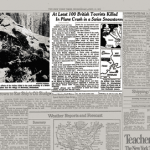
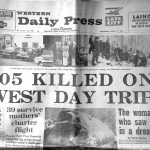
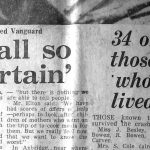

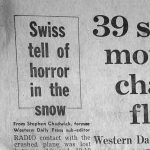
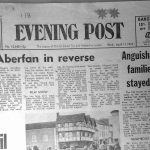
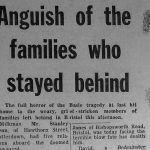
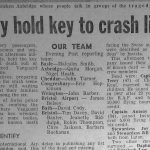
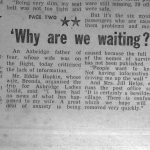
Leave a Reply